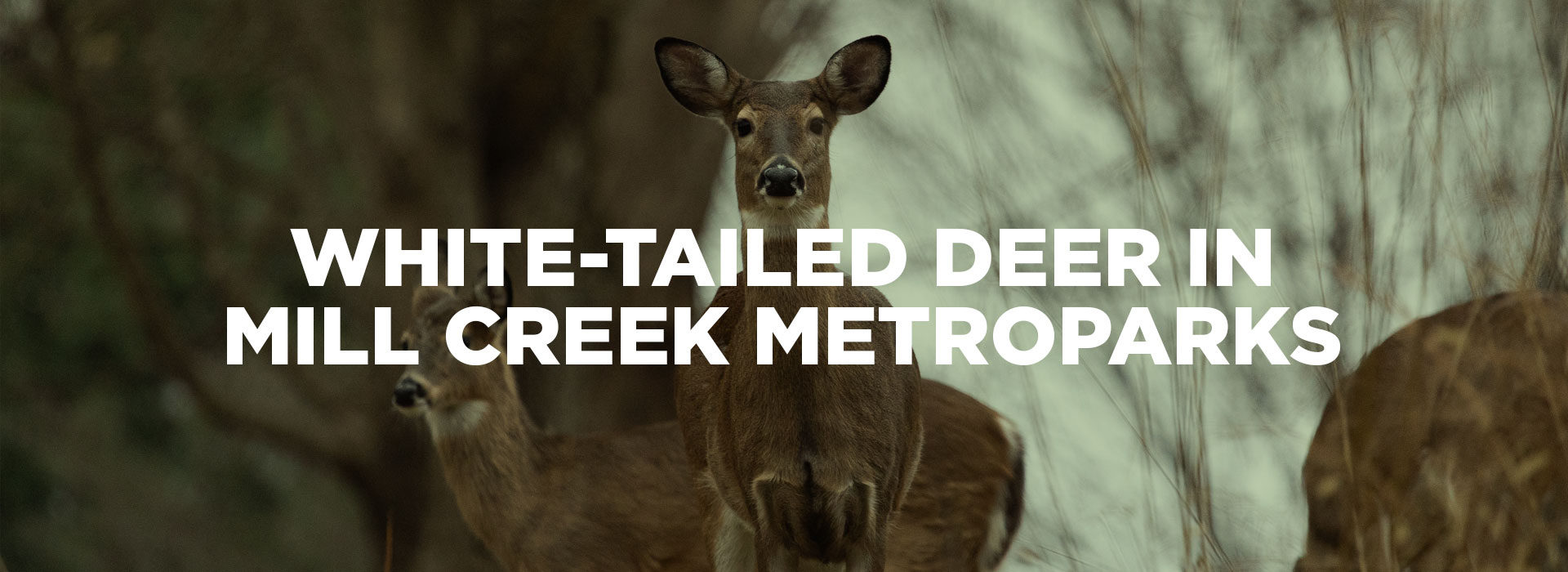The story of the white-tailed deer in Ohio is one of conservation success with populations rebounding from extirpation in the early 1900s to a population peaking in the early 2000s at over 700,000 individuals. The vast majority of that population growth has been seen in the last 50 years (~17,000 deer statewide in 1970) this exponential growth can be attributed in large part to the extremely adaptable nature of the white-tailed deer as they can thrive in a variety of landscapes across the state.
Under the seven pillars of the North American Model of Wildlife Conservation, wildlife in Ohio is owned in public trust and is managed statewide by the Ohio Department of Natural Resources: Division of Wildlife.
Frequently Asked Questions
What Is The Current Status of the Deer Herd on MetroParks Property?
Current population estimates across all MetroParks properties indicate a severe overabundance of white-tailed deer. On average, MetroParks properties exhibit population densities more than 19x higher than recommended levels. This has been a documented problem within the MetroParks dating back to the late 1990s and has led to extensive ecological damage to the native flora/fauna found throughout Mill Creek Park and other regional preserves.
Additional Resources:
What Does It Mean to Have an Overabundance of White-tailed Deer?
An overabundance of deer can be defined as having populations which exceed the carrying capacity of the land. Ecological carrying capacity, is the point in which populations of white-tailed deer exceed the available food resources available on the landscape and begin having negative impacts to the surrounding environment. Research indicates 10-20 deer/mi2 as the ideal range for population densities to remain below ecological carrying capacity.
Additional Resources:
- Presentation Part 1 – Slide 36
How Does Having an Overabundance of Deer Negatively Impact the MetroParks?
Overbrowsing caused by the overabundance of white-tailed deer on the landscape can have numerous negative impacts to the environment such as a loss of biodiversity and stunted forest regeneration. These impacts can have long lasting and/or permanent effects to the vegetative community onsite, affecting many other species of wildlife across all trophic levels. In addition, high population densities can lead to poor health of the deer herd and the spread of disease.
Additional Resources:
How Are Population Levels Estimated?
Populations of white-tailed deer can be estimated by using a numbers of different survey methods, the most comprehensive and accurate method being an aerial survey which utilizes infrared imagery to document deer across the landscape – this method is generally considered ~80% accurate or more depending upon survey conditions. Aerial surveys were first implemented in areas of the MetroParks in the 1990s which included Hitchcock Woods, Huntington Woods, and Mill Creek Park (South of Shields Rd.) the first comprehensive aerial survey of all MetroParks properties was not conducted until 2022.
Due to their comprehensive nature and high degree of accuracy, aerial surveys will continue to be the primary tool to monitor our deer herd moving forward but will be supplemented with other survey methods such as trail cameras, browse surveys, roadway surveys, etc. as the situation dictates.
Additional Resources:
What Can Be Done To Manage Our Deer Herd?
The Ohio Division of Wildlife has authority over all deer management within the State of Ohio. All management activities must align with current methods approved by the Division of Wildlife.
Based upon current survey data regarding overall deer densities, ecosystem health, and public input the MetroParks is recommending the implementation of a facility-based management program to manage white-tailed deer populations on MetroParks properties.
This program will employ a combination of proven options, based on current scientific research and best management practices approved by the Ohio Division of Wildlife. These methods will include both a controlled hunting program in partnership with the Ohio Division of Wildlife and a targeted removal program in partnership with USDA APHIS Wildlife Services. The controlled hunting portion of the deer management plan will focus on select regional facilities located in more rural areas of the county where hunting has been deemed safe and ecologically feasible. Targeted removal will take place in more urbanized areas deemed unfeasible for controlled hunting due to available acreage and/or public usage.
Additional Resources:
- Presentation Part 2 – Slide 41
- Presentation Part 2 – Slide 44
- Ohio Department of Natural Resources: Controlled Hunting
Are Non-Lethal Management Techniques Such As Fertility Control a Viable Option?
No, fertility control is currently not an option that is permitted for deer management programs by the Ohio Division of Wildlife, outside of research settings. Fertility control for white-tailed deer has been intensively studied by other organizations which clearly document that fertility control is ineffective at managing populations of wild free-ranging deer.
Additional Resources:
Presentation Part 2 – Slide 43
How Long Will Management Activities Take Place?
Our management plan defines short and long-term goals, the first being to reduce populations levels to within ecological carrying capacity the goal is to achieve this within 5-10 years. Once reduction goals are met, the plan will transition into long-term management of our deer herd to keep populations at maintenance levels. The long-term management of the deer herd must continue on an annual basis to maintain population levels. Due to the exponential nature of white-tailed deer population growth, a lapse in long-term management would quickly negate any progress that had been made.
Additional Resources:
- Presentation Part 2 – Slide 53
How Will We Know When Management Goals Are Reached?
Continued population surveys coupled with ecological data will signify when management goals are met. These metrics will be evaluated on an annual basis and management objectives will vary accordingly.
- Presentation Part 2 – Slide 54

